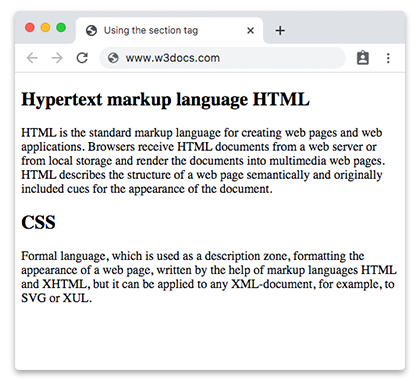HTML <section> is one of the HTML5 elements. It is used to create standalone sections within a webpage containing logically connected content (news block, contact information, etc.). The <section> tag is often used when creating a landing page to divide the page into separate logical blocks.
For example, a navigation menu must be wrapped in a <nav> tag, but a map display and a list of search results do not have specific elements, and can be put inside a <section>.
The <section> tag can be nested within the <article> tag, dividing the content into groups. Therefore, it is required to use <h1> -<h6> headings within the <article> and the <section> tags. It is allowed to use <h2> title in each section, defined with the <section> tag.
Syntax
The <section> tag comes in pairs. The content is written between the opening (<section>) and closing (</section>) tags.
Example of the HTML <section> tag:
<!DOCTYPE html>
<html>
<head>
<title>Using the section tag</title>
</head>
<body>
<section>
<h2>Hypertext markup language HTML</h2>
<p>HTML is the standard markup language for creating web pages and web applications. Browsers receive HTML documents from a web server or from local storage and render the documents into multimedia web pages. HTML describes the structure of a web page semantically and originally included cues for the appearance of the document.</p>
</section>
<section>
<h2>CSS</h2>
<p>Formal language, which is used as a description zone, formatting the appearance of a web page, written by the help of markup languages HTML and XHTML, but it can be applied to any XML-document, for example, to SVG or XUL.</p>
</section>
</body>
</html>Result

Example of the HTML <section> tag inside another <section> tag :
<!DOCTYPE html>
<html>
<head>
<title>Title of the document</title>
</head>
<body>
<h1>Example of the sectoin tag</h1>
<section>
<h2>Hypertext markup language HTML</h2>
<p>
HTML is the standard markup language for creating web pages and web applications. Browsers receive HTML documents from a web server or from local storage and render the documents into multimedia web pages. HTML describes the structure of a web page semantically and originally included cues for the appearance of the document.
</p>
<section>
<h3>Hypertext markup language HTML</h3>
<p>HTML is the standard markup language for creating web pages and web applications. Browsers receive HTML documents from a web server or from local storage and render the documents into multimedia web pages. HTML describes the structure of a web page semantically and originally included cues for the appearance of the document.</p>
</section>
</section>
<section>
<h2>CSS</h2>
<p>Formal language, which is used as a description zone, formatting the appearance of a web page, written by the help of markup languages HTML and XHTML, but it can be applied to any XML-document, for example, to SVG or XUL.</p>
</section>
</body>
</html>Attributes
The <section> tag supports the the Global Attributes and the Event Attributes.
How to style <section> tag?
Common properties to alter the visual weight/emphasis/size of text in <section> tag:
- CSS font-style property sets the style of the font. normal | italic | oblique | initial | inherit.
- CSS font-family property specifies a prioritized list of one or more font family names and/or generic family names for the selected element.
- CSS font-size property sets the size of the font.
- CSS font-weight property defines whether the font should be bold or thick.
- CSS text-transform property controls text case and capitalization.
- CSS text-decoration property specifies the decoration added to text, and is a shorthand property for text-decoration-line, text-decoration-color, text-decoration-style.
Coloring text in <section> tag:
- CSS color property describes the color of the text content and text decorations.
- CSS background-color property sets the background color of an element.
Text layout styles for <section> tag:
- CSS text-indent property specifies the indentation of the first line in a text block.
- CSS text-overflow property specifies how overflowed content that is not displayed should be signalled to the user.
- CSS white-space property specifies how white-space inside an element is handled.
- CSS word-break property specifies where the lines should be broken.
Other properties worth looking at for <section> tag:
- CSS text-shadow property adds shadow to text.
- CSS text-align-last property sets the alignment of the last line of the text.
- CSS line-height property specifies the height of a line.
- CSS letter-spacing property defines the spaces between letters/characters in a text.
- CSS word-spacing property sets the spacing between words.
Browser support
|
|
|
|
|
|---|---|---|---|
| 6+ | 4+ | 5+ | 11.1+ |
Practice Your Knowledge
Quiz Time: Test Your Skills!
Ready to challenge what you've learned? Dive into our interactive quizzes for a deeper understanding and a fun way to reinforce your knowledge.